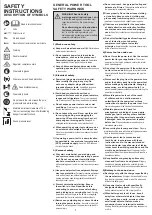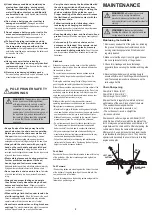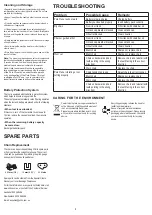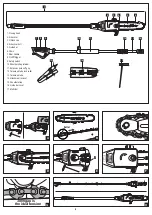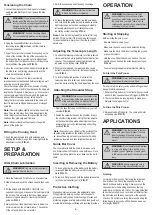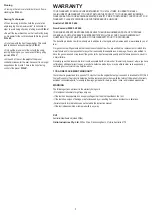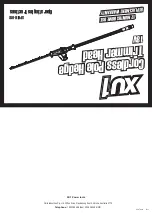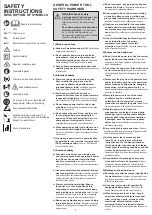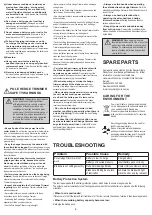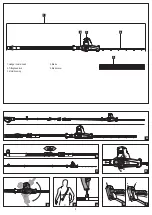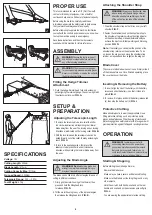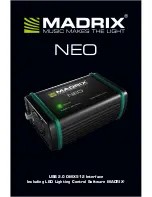
Operating Instructions
XLBP-0185
18V
18V
1.5Ah Lithium Ion
1.5Ah Lithium Ion
Battery
Battery
SAFETY
INSTRUCTIONS
DESCRIPTION OF SYMBOLS
Regulatory Compliance Mark (RCM)
Do not incinerate
Lithium Ion-battery
Recycle battery
Do not put in rubbish
Do not get battery wet
ELECTRICAL SAFETY
Read the whole manual carefully and make sure you know how to switch
the tool off in an emergency, before operating the tool.
Save these instructions and other documents supplied with this tool for
future reference.
This tool has been designed for 230V and 240V only. Always check that the
power supply corresponds to the voltage on the rating plate.
Note:
The supply of 230V and 240V on Ozito tools are interchangeable for
Australia and New Zealand.
This tools charger is double insulated; therefore no earth wire is required.
Using an Extension Lead
Always use an approved extension lead suitable for the power input of this
tool. Before use, inspect the extension lead for signs of damage, wear and
ageing. Replace the extension lead if damaged or defective.
WARNING!
When using mains-powered tools, basic
safety precautions, including the following, should always
be followed to reduce risk of fire, electric shock, personal
injury and material damage.
BATTERY SAFETY
WARNINGS
BEFORE USING THE CHARGER OR BATTERY READ
ALL INSTRUCTIONS AND CAUTIONARY MARKINGS
ON THE CHARGER, BATTERY PACK AND THE
PRODUCT USING THE BATTERY PACK. DO NOT LOSE
THESE SAFETY INSTRUCTIONS.
1. The battery pack is not fully charged out of the carton. First read the safety
instructions and then follow the charging notes and procedures.
2. For optimum battery performance avoid low discharge cycles. Charge the battery
pack frequently.
3. Use and store the battery pack in dry conditions with low humidity between 0-40
°
C,
ideally at 15
°
C. Avoid exposing battery pack and charger to direct sunlight.
4. Do not keep battery pack in places where temperatures are liable to reach over 40
°
C,
such as in a car, metal shed or similar that is in direct sunlight.
5. Do not ignite the battery pack or expose it to fire. There is a risk of explosion!
6. Do not exhaustively discharge batteries. Exhaustive discharge will damage the battery
cells. The most common cause of exhaustive discharge is long-term storage and
continued use of low-charge batteries. Always store the battery with some charge.
Charge the batteries every 2-3 months to restore charge. Stop working as soon as
the performance of the battery falls noticeably or the electronic protection system
triggers.
7. Protect batteries and the tool from overloads. Overloads will quickly result in
overheating and cell damage inside the battery housing without this overheating being
apparent externally.
8. Avoid damage and shocks. Do not use batteries which have been dropped from a
height of more than one meter or strong external impact, even if the housing of the
battery pack appears to be undamaged. The battery cells inside the battery may have
suffered serious damage.
9. If the battery pack suffers overloading and overheating, the integrated protective
cut-off will switch off the equipment. Do not press the ON/OFF switch on the tool if the
protective cut-off has actuated. This may damage the battery pack. Allow the battery
to cool to room temperature before use.
10. Use only original battery packs. The use of other batteries may result in injuries,
explosion and a fire risk.
11. Protect your rechargeable battery against moisture, rain and high humidity. Moisture,
rain and high humidity can cause dangerous cell damage. Never charge or use
batteries which have been exposed to moisture, rain or high humidity.
12. Never attempt to open the battery pack for any reason. If the plastic housing of the
battery pack is damaged, do not use the battery.
13. When battery pack is not in use, keep it away from other metal objects, like paper
clips, coins, keys, nails, screws or other small metal objects, that can make a
connection from one terminal to another. Shorting the battery terminals together may
cause burns or a fire.
14. Under abusive conditions, liquid may be ejected from the battery; avoid contact. If
accidental contact occurs, flush with water and seek medical help immediately. Liquid
ejected from the battery may cause irritation or burns.
15. Do not use a battery pack or tool that is damaged or modified. Damaged or modified
batteries may exhibit unpredictable behaviour resulting in fire, explosion or risk of
injury.
16. Do not expose a battery pack or tool to fire or excessive temperature. Exposure to
fire or temperature above 130 °C may cause explosion.
17. Never service damaged battery packs. Service of battery packs should only be
performed by the manufacturer.
18. Do not disassemble Battery. This may result in a risk of electric shock, electrocution
or fire.
19. The longest life and best performance can be obtained if the battery pack is charged
when the air temperature is between 18-24
°
C. Do not charge the battery pack in an
air temperature below 10C or above 40
°
C. This is important and will prevent damage
to the battery pack.
20. During charging, the battery must be placed in a well ventilated area.
Ozito Industries Pty. Ltd. 25 Fox Drive, Dandenong South, Victoria, Australia 3175
Telephone:
1800 069 486 (Aus), 0508 069 486 (NZ)
XU1 Power tools
XLBP-0185 0222
Read instruction manual
When using an extension lead on a reel, always unwind the lead completely. Use of
an extension lead not suitable for the power input of the tool or which is damaged or
defective may result in a risk of fire and electric shock.
The power supply for this product should be protected by a residual current device
(rated at 30mA or less). A residual current device reduces the risk of electric shock.
This appliance is not intended for use by persons (including children) with reduced
physical, sensory or mental capabilities, or lack of experience and knowledge, unless
they have been given supervision or instruction concerning use of the appliance by a
person responsible for their safety.
Children should be supervised to ensure that they do not play with the appliance.
V
Volts
Hz
Hertz
~
Alternating current
Wh
Watt hours
dc/
Direct current
Ah
Amp hour
Warning
Do not use or store battery in
temperatures exceeding 40
0
C
MAX.40
o
C


